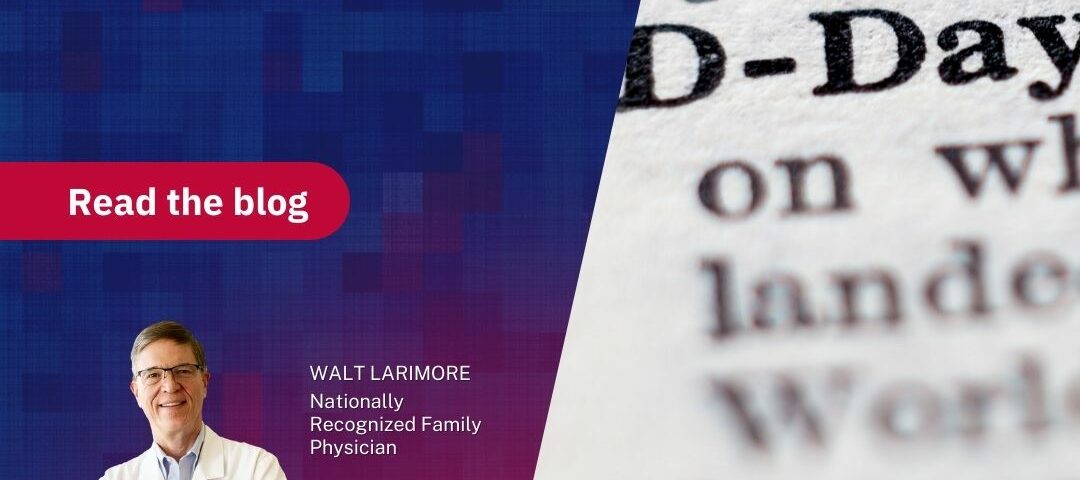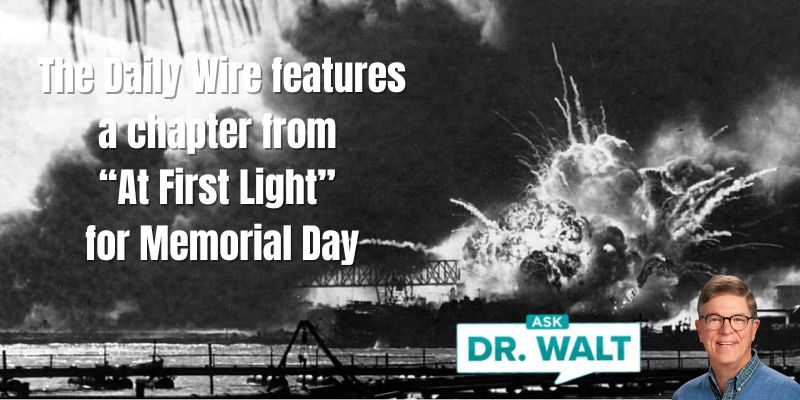
Spiritual Assessment (or Spiritual History) in Clinical Care
June 5, 2022
Many parents are making a mistake that could increase their baby’s risk of SIDS
June 7, 2022Here’s an Op-Ed I wrote titled, “What should our D-Day anniversary mean?” It ran in today’s Washington Examiner newspaper in Washington, D.C. I hope it will be a blessing (and perhaps a surprise) to you. If so, please share this with family and friends so we can all remember together the amazing sacrifices, suffering, and successes of these incredible soldiers.
D-Day. Ask the average person what that means, and they’ll mention something about the amphibious landings in Normandy, France, on June 6, 1944 – to begin the land battles on the Northern Front of the European Theater of Operations (ETO) in World War II.
Most don’t know that the men on the Southern Front of the ETO had five D-Days? Their amphibious landings on the shores of French Morocco (November 8, 1942); Sicily (July 9, 1943); Salerno, Italy (September 3, 1943); Anzio, Italy (January 22, 1944); and Southern France (August 15, 1944). And the 3rd Battalion of the 30th Infantry Regiment, with which my father fought, had those five and another two on Sicily.
But that pales when compared to the Pacific Theater of Operation (PTO) during World War II where there were more than one hundred D-Days. Many of the amphibious assaults during the PTO were on Japanese-held islands and were among the most savagely fought battles in American history: Guadalcanal, Tarawa, Saipan, New Guinea, Peleliu, Leyte Gulf, and Iwo Jima. The largest – and last – D-Day was the invasion of Okinawa on April 1, 1945, which brought together the biggest invasion fleet ever assembled, far larger than that engaged in the Normandy invasion.
“D-Day” is just military code for the beginning of any offensive operation. If we were to add all the land-based D-Days for major battles in the ETO and PTO during World War II, there are over 60 to add to those above. If we add in the hundreds of other battles with D-Days, we’d be well over a thousand – each requiring precise planning, technical and operational support, air and artillery support, and amazing sacrifice and suffering by the front-line troops for success. Yet most have been relegated to the dustbins of history and forgotten by almost all Americans.
For example, while I studied the feats of the men who fought on the southern front of the ETO, I would ask people to name the first European capital liberated by the Allies, and the most common answer was, “Paris.” That occurred in August 1944, almost 12 weeks after the Southern soldiers liberated Rome on June 4-5, 1944. Unfortunately, news about Rome’s emancipation was buried by the Normandy invasion on June 6. Newsrooms rushed to replace front-page stories recounting the battles to free Rome with even larger headlines about Normandy. From that moment on, the Southern Front became, in essence, the “Forgotten Front.”
Another case in point: many have heard of the Northern Army’s horrific Battle of Hürtgen Forest throughout the fall and winter of 1944, but few remember the arguably more gruesome and arduous battles fought in the Vosges Mountains at the same time. In three months of ferocious fighting in severe conditions, the Southern Front G.I.s accomplished what no army in the history of warfare had ever done before—conquer an enemy defending the Vosges Mountains—and in winter no less!
Most know about the Northern Front’s monumental Battle of the Bulge, but almost no one remembers the fierce and potentially more disastrous Battle of the Colmar Pocket and its decisive Battle at La Maison Rouge—waged in some of the worst winter wartime conditions ever recorded. Historian Stephen Ambrose wrote, “It was fought in conditions so terrible that they can only be marveled at, not really imagined.” He added, “Only those who were there can know. More than once in interviewing veterans of the January fighting, when I ask them to describe the cold, men involuntarily shivered.”
What every D-Day in the ETO and PTO shared in common, was that the front-line soldiers faced and conquered fear, heartbreak, dread, chaos, stench, casualties, wounds, and unimaginable opposition. Many times, they faced battles they feared would end in inevitable defeat or certain death. They sacrificed the daily comforts most consider essential. Those that returned to the home front savored each new day, each breath, in a new way. They knew their many friends in battle who had left their all on the altar of war—who had sacrificed their tomorrows—had allowed them and us to live—truly live—for all their and our todays.
Of the ~12 million who served in the military in WWII, there were just over one million casualties: ~417,000 killed and another ~671,000 wounded. Only about 200,000 are left (most in their 90s) — the others have graduated to eternal glory—and the VA estimates we’re losing 200-300 of these amazing veterans per day.
All our military men and women deserve to be remembered and honored on D-Day, especially those who gave the ultimate sacrifice, but a special shout-out for those who suffered and sacrificed on every single D-Day, not just those who stormed the beaches of Normandy, is long overdue. Almost all are gone now, but as Gen. Lucian K. Truscott said, “We cannot look back to them if we do not look forward to the future for which they fought — and died.” So, as we celebrate our continued liberty and freedom on this D-Day anniversary, my hope and prayer are that the heroes who fought and died on our D-Days will be forgotten no longer.
Walt Larimore, a Colorado-based physician, and best-selling author spent significant parts of the last 16 years studying the “Forgotten Front” of Northern African and Southern Europe in World War II while researching his book, At First Light: A True World War II Story of a Hero, His Bravery, and an Amazing Horse. The book was released by Knox Press in April.
© Copyright WLL, INC. 2022. This blog provides healthcare tips and advice that you can trust about a wide variety of general health information only and is not intended to be a substitute for professional medical advice, diagnosis, or treatment from your regular physician. If you are concerned about your health, take what you learn from this blog and meet with your personal doctor to discuss your concerns.





